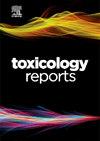Assessment of heavy metal pollution and human health risk in the soil of selected tea plantations from southern Western Ghats, Tamil Nadu, India
Q1 Environmental Science
引用次数: 0
Abstract
Soil pollution on agricultural land has become a significant concern in major tea-producing regions, including Tamil Nadu, a prominent tea-producing state in India. The excessive use of agrochemicals in tea plantations leads to soil contamination, which in turn pollutes tea plantation soil. Tea soil samples were collected in six different tea plantations in commercially important regions from Valparai (Coimbatore), Coonoor, Kundha, Kothagiri, Kattabettu, and Gudalur (Nilgiris), in Tamil Nadu, India. The samples were taken from depths of 0–25 cm across distances ranging from 0–250 m. These samples were digestion procedure followed AOAC method. To assess human health risks, both carcinogenic and non-carcinogenic effects will be evaluated across three primary exposure pathways: ingestion, inhalation, and dermal contact. The study conducted in six major tea-cultivated soils. Five tea plantations' soil samples are highly contaminated with cadmium and at high risk. Geoaccumulation index shows cadmium strongly contaminated in Valparai, Coonoor, and extremely contaminated in Kundha, Kothagiri, and Ooty tea soil samples. The Total Cancer Risk (TCR) in the study area mainly ingestion route values: Cd (0.0000364–0.0000583), followed by Cr (0.0000293–0.0000468), As (0.0000105–0.0000168), and Ni (0.00000269–0.00000431) All the values were higher than USEPA’s of 1 × 106–1 × 104 (USEPA, 2004) consequently, children’s health will be severely affected compared to adults. The current study shows that due to the excess use of agrochemicals and short tea crop cultivation periods, a large amount of heavy metals accumulates in tea plantation soil. As a result, understanding toxic metals and emphasizing the reduction of agrochemicals and the extension of the tea crop cultivation period is crucial. Because soil health is key for food quality, sustainable agriculture, and increasing economic value.
印度泰米尔纳德邦西高止山脉南部选定茶园土壤重金属污染及人类健康风险评估
农业用地的土壤污染已经成为主要产茶地区的一个重大问题,包括印度著名的产茶邦泰米尔纳德邦。茶园过度使用农用化学品导致土壤污染,进而污染茶园土壤。在印度泰米尔纳德邦的瓦尔帕莱(哥印拜陀)、库努尔、昆达、Kothagiri、Kattabettu和Gudalur (Nilgiris)六个商业重要地区的不同茶园收集了茶叶土壤样本。采样深度为0-25 厘米,距离为0-250 米。样品采用AOAC法消化。为了评估人类健康风险,将通过三种主要接触途径评估致癌和非致癌效应:摄入、吸入和皮肤接触。该研究在六个主要的茶叶种植土壤中进行。5个茶园土壤样品镉污染严重,存在高风险。土壤累积指数显示,瓦尔帕莱、库诺尔茶土壤镉重度污染,昆达、科塔吉里和乌蒂茶土壤镉重度污染。研究区总的癌症风险(TCR)主要为摄入途径值:Cd(0.0000364-0.0000583),其次为Cr(0.0000293-0.0000468)、As(0.0000105-0.0000168)和Ni(0.00000269-0.00000431),均高于USEPA的1 × 106-1 × 104 (USEPA, 2004),与成人相比,儿童的健康将受到严重影响。目前的研究表明,由于农用化学品的过量使用和茶园种植周期短,导致茶园土壤中重金属大量积累。因此,了解有毒金属,强调减少农药的使用和延长茶树栽培期是至关重要的。因为土壤健康是食品质量、可持续农业和增加经济价值的关键。
本文章由计算机程序翻译,如有差异,请以英文原文为准。
求助全文
约1分钟内获得全文
求助全文
来源期刊

Toxicology Reports
Environmental Science-Health, Toxicology and Mutagenesis
CiteScore
7.60
自引率
0.00%
发文量
228
审稿时长
11 weeks
 求助内容:
求助内容: 应助结果提醒方式:
应助结果提醒方式:


